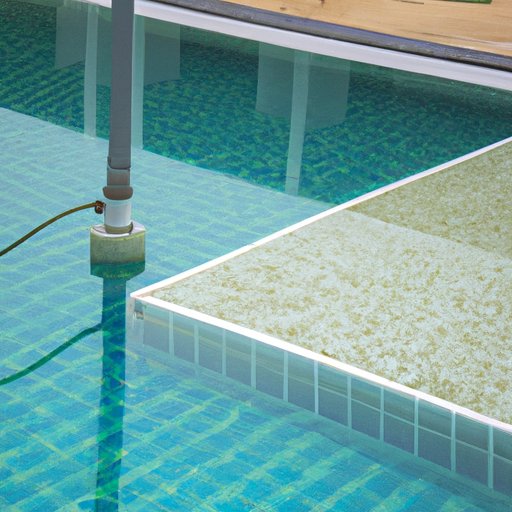
I. Introduction
Cloudy pool water is a common problem for pool owners and can be caused by a variety of factors such as poor filtration, chemical imbalances, and debris buildup. Not only does it make swimming unpleasant, but it can also be a sign of poor pool health. In this article, we will provide a comprehensive guide on how to clear cloudy pool water fast and prevent it from happening again.
II. Chemical Treatment
Chemical treatment is one effective way to clear cloudy pool water fast. Here are three common chemical treatments:
Chlorine Shock Treatment:
This treatment involves adding a large amount of chlorine to the pool. This high dose of chlorine helps break down any organic matter such as algae or bacteria that may be present in the water. It is best to use this treatment when the pool is not in use and in the evening to allow the chlorine to work overnight. When using this method, it is important to follow the manufacturer’s instructions and calculate the correct amount of chlorine to add based on your pool size.
Algaecide Application:
If the cloudiness is caused by algae, an algaecide can help. Algaecides work by killing and preventing algae growth. Follow the manufacturer’s instructions for the proper amount to add based on your pool size. It’s important to note that while algaecides can help clear up the water, they won’t remove any debris that may be present.
Flocculant Application:
Flocculant application is a method that involves adding a chemical that forms a bond with particles in the water, creating larger clumps that can then be easily filtered out. This method requires a lot of filtration to be effective, so it’s recommended to run the pool’s filter for several hours after adding the flocculant.
III. Filtration System
Properly maintaining and using your filtration system is crucial for clear pool water. Here are some things to keep in mind:
The Importance of Cleaning and Backwashing the Filter:
A dirty filter can cause cloudy water, so it is important to regularly clean and backwash your filter. Backwashing involves running water through the filter in the reverse direction, flushing out any trapped debris. Aim to backwash your filter once a week and clean your filter every few months, depending on usage.
How to Properly Operate the Filtration System:
Make sure to run your pool’s filtration system for at least 8-12 hours a day, especially during the summer months. Also, ensure that the water level does not drop below the skimmer so that the filter can properly operate.
IV. Skimming Debris
Skimming debris from the pool’s surface is an essential aspect of pool maintenance and can help prevent cloudy water. Here are some tips:
How to Use a Skimmer Net Effectively:
Make sure to skim your pool regularly and use a net that is big enough to collect debris without letting it escape. Use long, sweeping motions along the surface of the water to collect as much debris as possible.
Different Types of Debris that can be Removed by Skimming:
Skimming can remove a variety of debris, such as leaves, insects, and dirt. Removing these materials from the pool will not only help with clarity but also prevent potential clogs in the filtration system.
V. Cleaning the Pool
Cleaning the walls and floor of your pool can also help to prevent and solve cloudy water. Here’s what you need to know:
How to Clean the Walls and Floor of the Pool Effectively:
Use a pool brush to scrub the walls and floor of the pool. Pay special attention to any areas with visible buildup. You can also use a pool vacuum to remove any debris that has settled on the bottom of the pool.
Importance of Routine Maintenance:
Clean your pool on a regular basis to help prevent cloudy water. Take care of any visible buildup such as algae or debris right away to prevent it from worsening.
VI. Fixing any Chemical Imbalances
Chemical imbalances can also cause cloudy pool water. Here’s what to do to fix it:
Steps to Take to Test and Adjust Pool Chemical Levels:
Test your pool water regularly to ensure that the chemical levels such as pH, alkalinity, and calcium are in the ideal range. Follow the manufacturer’s instructions when adding chemicals to promote balance.
Ideal Levels for pH, Alkalinity, and Calcium:
The ideal pH range for pools is between 7.2 and 7.8, the ideal alkalinity range is between 80 and 120 ppm, and the ideal calcium hardness range is between 200 and 400 ppm.
VII. Call a Professional
If your pool water is still cloudy after trying these methods, it may be time to call in a professional pool cleaner. Here’s what to look for:
When to Consider Calling in a Professional Pool Cleaner:
If none of the above methods work, it’s time to consider a professional pool cleaner. A professional will be able to diagnose and treat any complex issues beyond your level of expertise.
How to Find and Hire a Reputable Professional:
Do your research online or ask for referrals from friends to find a reputable professional. Make sure to ask for proof of qualifications and insurance before hiring them.
The Potential for More Complicated Pool Issues that May Require Assistance:
Cloudy pool water may be a sign of more significant pool issues that require professional assistance. These may include pump malfunctions, issues with the pool’s plumbing, or even structural damage.
VIII. Conclusion
In conclusion, there are a variety of methods to clear cloudy pool water quickly, such as chemical treatment, filtration systems, skimming debris, cleaning the pool, fixing chemical imbalances, and calling in a professional. However, the best way to prevent cloudy water in the first place is through regular pool maintenance.




